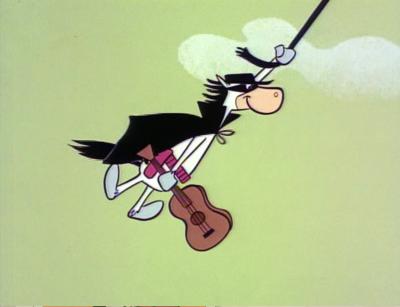

The series finale saw our hero pit his wits against the despicable villains, but unfortunately causing more mayhem than he was solving, thanks to his clumsiness.Įl Kabong is asked why he hides behind a mask and he replies, it’s because nobody takes his face seriously. The final episode, The Mark Of El Kabong, saw Quick Draw assume the identity of his alter ego, El Kabong, who was a masked vigilante who was a spoof of Zorro. The original series aired 45 episodes, in which Quick Draw and his trusty sidekicks apprehended the bad guys in a series of many Wild West adventures, while creating their own brand of chaos. The original series of Quick Draw McGraw was broadcast from 1959 to 1962, wining an EMMY award for Outstanding Children’s Programme in 1960. Quick Draw McGraw was filmed in colour and by the 1960s, when more households were buying colour sets, they could better appreciate the cartoons.
Quickdraw mcgraw el kabong tv#
A few dozen television operators had applied for licences by the end of the 1940s and by the mid-1950s, statistics showed around 50% of all US households had a TV set.īy the time the first episode of Quick Draw McGraw was broadcast in 1959, many households had a television set, although the majority could afford only black and white, as colour was a premium feature in the early days. In the mid-1950s, television was just beginning to grow in popularity in American homes.

It was part of a genre known as anthropomorphism, in which animals were given human traits, characteristics and emotions. Quick Draw McGraw was created in the late 1950s by Michael Maltese – a writer who was best-known for his work at Warner Bros cartoon studio – and famous American animators William Hanna and Joseph Barbera. Calling himself Daws Butler, he worked mainly for the Hanna-Barbera studio which produced Quick Draw McGraw.ĭuring his 53-year career in entertainment, Butler also voiced other popular animated characters, such as Yogi Bear, Huckleberry Hound and Elroy Jetson. The funny thing about the show, was that even though the lead character was a horse who walked upright and could carry a revolver in his hoof, the writers depicted him riding along on a realistic-looking horse or driving a horse-drawn stagecoach!Ĭharles Dawson Butler, an Ohio-born actor who specialised in providing the voices for animated films, voiced both Quick Draw and Baba Looey. He prefers biscuits as a reward for capturing outlaws, so when Quick Draw McGraw gives him the cash instead, he mutters, “Darn cheapskate!” His character is the sheriff in a Wild West town and he fights crime with his sidekick, a small donkey known as a burro, called Baba Looey.Īnother regular character is Snuffles, his bloodhound dog, who is often found demanding biscuits and leaping up into the air in unbridled joy when he eats one. The taking horse walks upright on two legs and wears a cowboy hat and bandana, with a bullet belt slung round his hips. Of course, we’re talking about Quick Draw McGraw! A caricature horse who has all the attributes of a cowboy, he can be found fighting the villains in the Old West. It’s no surprise that one kids’ show that combined animation with the Wild West has gone down in history as being a cult cartoon.

For many, entertainment meant watching the cartoons, or cheering with the cowboy movies at the cinema on a Saturday morning. Before new technology led to a multitude of cable channels and streaming movies, children growing up in the late 1950s enjoyed simpler pleasures.


 0 kommentar(er)
0 kommentar(er)
